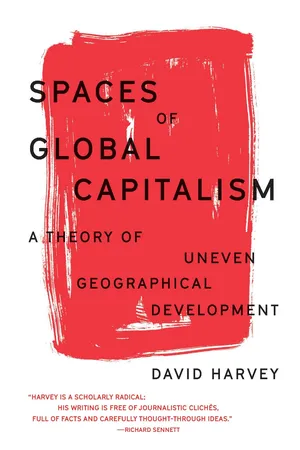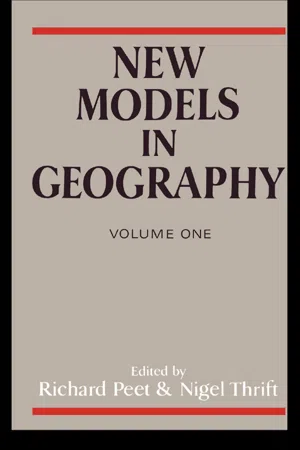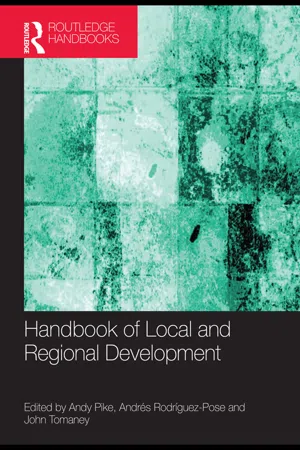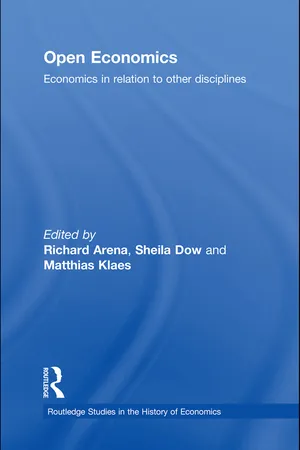Geography
Uneven Development
Uneven development refers to the unequal distribution of economic, social, and political resources across different regions or countries. It highlights disparities in infrastructure, wealth, and opportunities, leading to imbalances in development. This concept is central to understanding the spatial variations in prosperity, poverty, and access to resources within and between different geographical areas.
Written by Perlego with AI-assistance
Related key terms
Related key terms
1 of 4
Related key terms
1 of 3
8 Key excerpts on "Uneven Development"
- eBook - ePub
Spaces of Global Capitalism
A Theory of Uneven Geographical Development
- David Harvey(Author)
- 2019(Publication Date)
- Verso(Publisher)
NOTES TOWARDS A THEORYOF UNEVEN GEOGRAPHICALDEVELOPMENTDavid HarveyNotes towards a theory ofuneven geographical developmentPreambleThe theory of uneven geographical development needs further development. The extreme volatility in contemporary political economic fortunes across and between spaces of the world economy (at all manner of different scales) cry out for better theoretical interpretation. The political necessity is just as urgent since convergence in well-being has not occurred and geographical as well as social inequalities within the capitalist world appear to have increased in recent decades. The promised outcome of poverty reduction from freer trade, open markets and “neo-liberal” strategies of globalization has not materialized. Environmental degradations and social dislocations have also been unevenly distributed. Simultaneously, the uneven geographical development of oppositional movements to neo-liberalism creates both opportunities and barriers in the search for alternatives.There is nothing new, of course, about uneven geographical development within capitalism or, for that matter, within any other mode of production. There are, moreover, several overlapping ways of thinking about it:1) Historicist/diffusionist interpretations treat the political economic development of the advanced capitalist countries (the West) as the engine of capitalism that entrains all other territories, cultures and places into paths of economic, political, institutional and intellectual progress. Uneven geographical development is interpreted as the product of a differentiated diffusion process from the center that leaves behind residuals from preceding eras or meets with pockets of resistance towards the progress and modernization that capitalism promotes. “Backwardness” (the term is highly significant) arises out of an unwillingness or an inability (in racist versions considered innate, in environmentalist versions seen as naturally imposed, and in culturalist versions understood in terms of the weight of historical, religious etc. traditions) to “catch up” with the dynamics of a western-centered capitalism, usually portrayed as the highpoint of modernity or even of civilization. Whole populations, cultures and territories are thereby presumed to be incapable of shaping their own history let alone of influencing developments elsewhere. Occasionally some place “sees the light” (e.g. Japan and more recently much of East and Southeast Asia) and forges ahead. But the rest of the world lives in “the waiting room of history.” There are conservative, liberal and Marxist versions of this historicist/diffusionist argument. - eBook - ePub
New Models in Geography - Vol 1
The Political-Economy Perspective
- Richard Peet, Nigel Thrift, Richard Peet, Nigel Thrift(Authors)
- 2002(Publication Date)
- Routledge(Publisher)
This integration of the theory of capital accumulation with uneven geographical development has been challenged, especially by Browett (1984; see also Smith 1986b), who argues that far from being systematic and integral to capitalist development geographical unevenness may be an accidental byproduct resulting from contingent forces. Others have sought to explore further the theoretical basis of a geography of capitalism. Mizuoka (1986) gives many of these ideas a technical foundation with the help of Japanese mathematical economics, identifying a progressively expanding and deepening real subsumption of space to capital. In a fascinating series of papers, Webber and others (Webber 1987a, 1987b, 1988, Webber & Rigby 1986, Foot & Webber 1983) provide a mathematical underpinning to several key concepts in Uneven Development theory and a sympathetic critique of common assumptions. A number of researchers confront theoretical analyses with actual historical patterns of change. Dunford & Perrons (1983), for example, sketch the continually transforming geographical arena of domestic British capital. Yet the most evocative historical accounts of uneven geographical development come from researchers less concerned with the abstract theoretical task of integrating space and society, and more concerned with a political evaluation of contemporary capitalist development. Lipietz (1982, 1984) and Harris (1983, 1987) both analyze the rise of the newly industrialized countries (NICs) in vividly geographical terms that point toward the decline of the traditional geographical definition of the difference between developed and underdeveloped nations. As Harris (1987) puts it, the industrialization of significant sectors of the underdeveloped world, however incomplete and unbalanced, has invalidated the ideology of the Third World geographically defined (see also Worsley 1979, Brett 1985).No neat lines strictly divide the different approaches to Uneven Development surveyed in this brief exposition which has omitted much that deserves inclusion. None the less, the discussion gives a sense of the range of theoretical analyses contributing directly, or less directly, toward a reformulation of location theory.A new location theory?
Theories of Uneven Development emerged not merely as a product of intellectual debates but in the context of sustained economic and geographical restructuring. Regional decline in the old industrial areas of many of the advanced capitalist nations was hardly new, but by the early 1970s was sharper and more widespread, affecting a broader array of industrial spaces. If chronic unemployment and depression in Clydeside and industrial New England had seemed comparatively invisible amid a more general postwar expansion, the sharpness of decline throughout the English north and the US northeast and midwest in the 1970s provoked the trenchant perception of an emerging regional problem (Holland 1976a, 1976b, Community Development Project 1977) and the recognition of a division between Sunbelt and Frostbelt (Sale 1975). Traditional location theory was revealed as incapable of explaining such a dynamic and richly diverse world, while the importance of Uneven Development theory was recognized as a link to the larger structure of capital accumulation and crisis. But even the latter was limited, in so far as it spoke to the most general rudiments of the geography of capitalism. Increasingly, a search was made for a middle-level industrial geography, theoretically informed, yet empirically specific as regards contemporary changes. Much of the theoretical work in this new location theory revolved around the concept of spatial divisions of labour. - eBook - ePub
- Andy Pike, Andres Rodriguez-Pose, John Tomaney, Andy Pike, Andres Rodriguez-Pose, John Tomaney(Authors)
- 2010(Publication Date)
- Routledge(Publisher)
Section II Defining the principles and values of local and regional developmentPassage contains an image
Towards a capabilities perspective? Diane Perrons5 Regional disparities and equalitiesIntroduction
The contemporary world is characterized by difference rather than uniformity and inequality on a global scale is stark and largely undisputed despite unparalleled wealth, advances in human ingenuity, and a vast array of policies to promote development and redress regional and gender inequalities. Interestingly, some of the widest regional and gender gaps exist in affluent countries and regions and among those experiencing high rates of economic growth, especially in India and China (Milanovic 2005b; Quah 2007).Uneven Development is variously viewed as an intrinsic characteristic of capitalist economic development and/or a necessary stage through which countries pass in their pathway to a high-income society. Depending on welfare regime or variety of capitalism, high levels of inequality are also found in mature high-income regions and income inequality is associated with higher levels of disadvantage in other spheres including health, education and crime (Wilkinson and Pickett 2009). If the meaning of regional development is to incorporate some sense of wellbeing, it is important to take note of inequalities within regions when measuring regional performances.In this chapter I explore the polarized character of contemporary growth processes and identify connections between growth and inequality as it is experienced by different social groups at the regional level. I consider the gulf between the highly developed institutional policies for promoting equality and diversity at all spatial scales and enduring inequality of outcomes. With some exceptions, a second gulf exists between policy aspirations for greater equality between social groups, reflected, for example, by the European Union’s (EU) requirement of gender mainstreaming in the Structural Funds, or the equality and diversity strategies of regional bodies such as the Regional Development Agencies (RDAs) in the UK, and the attention paid to equality and diversity in the academic literature on regional development, whether in the regional studies or regional science variants (McCann 2007; Morgan 2004; Pike et al. - eBook - ePub
- Kearrin Sims, Nicola Banks, Susan Engel, Paul Hodge, Jonathan Makuwira, Naohiro Nakamura, Jonathan Rigg, Albert Salamanca, Pichamon Yeophantong, Kearrin Sims, Nicola Banks, Susan Engel, Paul Hodge, Jonathan Makuwira, Naohiro Nakamura, Jonathan Rigg, Albert Salamanca, Pichamon Yeophantong(Authors)
- 2022(Publication Date)
- Routledge(Publisher)
More than just the feeling of suffering, tapping into the emotional geographies of development involves acknowledging how complex emotions and messy experiences of inequality may connect at a deeper level with people (Wright 2012). This focus on affective dimensions of what it means to experience development presents a different way to engage with spatial inequality beyond the visual as represented by mapping. The persistence of inequality continues to be a major challenge in development planning across the world. This chapter presented an overview of the diverse approaches to understanding and addressing spatial inequality in their analytical, policy and pedagogical diversity. Based on lessons from the experiences of dynamic regions in Asia and elsewhere, there is no one-size-fits-all model or strategy to spurring development and reducing spatial inequality. However, it can be argued that policies and programmes to target specific areas or regions for development will not succeed without a holistic approach that incorporates the multiple dimensions of inequality and the contextual particularities of places that contribute to the uneven geographies of well-being. Key sources Miller, M. (2021), Economic Development at the Community Level. Creating Local Wealth and Resilience in Developing Countries. Abingdon and New York: Routledge. This book provides a good overview of the magnitude of options local rural and urban communities have in order to improve living standards in the Global South. Kanbur, R.; Rhee, C. and Zhuang, J. (eds.) (2014), Inequality in Asia and the Pacific: trends, drivers, and policy implications. Mandaluyong City and Abingdon: ADB and Routledge. This book offers an insightful analysis of mostly economic inequalities in Asia. It can be used as a starting point from which to deepen investigations on spatial and other inequalities. Krishna, A. (2017), The Broken Ladder - eBook - ePub
- Wanning Sun, Yingjie Guo(Authors)
- 2013(Publication Date)
- Routledge(Publisher)
5 Uneven Development and the time/space economy
Carolyn Cartier
After three decades of rapid industrialization, the problems of inequality in the PRC reflect the geographical trajectory of the planned reform economy. From south to north and coast to interior, the uneven geography of reform has contributed to generating Uneven Development between regions and inequality between urban and rural areas (cf. Fan 1995; Findlay et al . 1995; Wang and Hu 1999; Goodman 2008b; Frazier 2010). While the major gaps are between the coast and interior and cities and the countryside, profound disparities also exist between registered urban residents and internal migrants, and between women and men (United Nations Development Program 2008). Economic inequality in China has challenged the social legitimacy of the PRC’s platform of rapid economic growth as the basis of societal development. Understanding these spatial inequalities is only partly explained by the history of prioritizing economic development in the coastal regions–the Pearl River delta, the Yangzi River delta and the Bohai Rim. In the words of Wang Shaoguang (2008: 20–1), ‘From a historical perspective, China has experienced an unprecedented transformation from a moral economy to a market society. … [Thus] people started to realize that economic growth did not necessarily mean social progress.’In growing recognition of the most serious disparities, the central government has introduced policies to address inequality between the regions and between urban and rural areas. The major development policy at the regional scale shifts priority to central and western regions through the ‘great opening of the West’, xibu dakaifa , campaign, known as the Western development strategy, introduced in 1999 and developed in the 10th (2001–05) and 11th Five-Year Plans (2006–10). To improve conditions in rural areas, a suite of new policies accompany the ‘ shehui zhuyi xinnongcun ’ (new socialist countryside) campaign, set forth in the 11th Five-Year Plan (People’s Daily 2006). The current rural policies are associated with the broader political-ideological policy programme, quanmian xiaokang (‘all-around small well-being’, or ‘ xiaokang society’), introduced in 2002 (People’s Daily 2002), which the United Nations Development Program (UNDP) helps promote in the rural sector. All these new measures are simultaneously imbricated in the prevailing state ideology, ‘ hexie shehui ’ (harmonious society), introduced in 2005 (People’s Daily - eBook - ePub
- Richard Arena, Sheila Dow, Matthias Klaes(Authors)
- 2009(Publication Date)
- Routledge(Publisher)
The focus is on the relation among industrial organisation, the geography of occupational structure, and their particular geographical distributions. Other empirical works focus on the geographical consequences of industrial restructuring (Peet 1986; Labrianidis 1987; Holmes 1988; Sandberg and Bradbury 1988). Among these, Storper and Walker (1989) attempt to unify geographical and territorial industrialisation in a single explanatory framework, in order to study what they call ‘the macrogeography of capitalist economies’. The attention is here concentrated on three main features of uneven capitalist development: territorial expansion, continuing differentiation among places, and instability of the relations between places. Industries keep moving due to the dynamism of capitalism development. Differences in industry growth paths are due to technology and the organisation of labour. Moreover, each wave of industrialisation brings into existence new centres and peripheries, stimulating disinvestment in some areas and radical restructuring in others, thus reshuffling spatial production relations. Other empirical studies pay attention to Uneven Development as the spatial form taken by the geography of capital accumulation (Amin 1973; Carney 1973; Breathnach 1988). Uneven Development is the general rule rather than the exception and it is intrinsic to capitalist development. Its source is related to the spatial division of labour, which is the product of competition between capitalists and which perpetually divides places, as much as firms and people, on the basis of their ability to differentiate their systems of production from those of their neighbours and competitors - eBook - ePub
- Gilles Duranton, Vernon Henderson, William Strange(Authors)
- 2015(Publication Date)
- North Holland(Publisher)
Chapter 22The Geography of Development Within Countries
Klaus Desmet* ; J. Vernon Henderson†* Department of Economics, Southern Methodist University, Dallas, TX, USA† Department of Geography, London School of Economics, London, UKAbstract
This chapter describes how the spatial distribution of economic activity changes as economies develop and grow. We start with the relation between development and rural–urban migration. Moving beyond the coarse rural–urban distinction, we then focus on the continuum of locations in an economy and describe how the patterns of convergence and divergence change with development. As we discuss, these spatial dynamics often mask important differences across sectors. We then turn our attention to the right tail of the distribution, the urban sector. We analyze how the urban hierarchy has changed over time in developed countries and more recently in developing countries. The chapter reviews both the empirical evidence and the theoretical models that can account for what we observe in the data. When discussing the stylized facts on geography and development, we draw on empirical evidence from both the historical evolution of today's developed economies and comparisons between today's developed and developing economies.Keywords Geography Development Space Growth City-size distribution Spatial distribution of economic activity Developed countries Developing countries Urban hierarchy Industrialization and urbanizationJEL Classification Codes R1 R11 R12 O1822.1 Introduction
As economies grow and develop, the spatial distribution of the population, employment, and production changes. Probably the most prominent feature of this spatial transformation is increased urbanization. Between 1950 and 2009, the world's urban population more than quadrupled from 732 million to 3.4 billion, as the world moved from being under 30% urbanized to over 50% urbanized. Understanding the patterns of this rapid transformation is of paramount importance to policy makers. More than 80% of governments are concerned about the geographic distribution of people, and nearly 70% of them have implemented policies to reduce internal migration (United Nations, 2010 - eBook - ePub
- Angang Hu(Author)
- 2006(Publication Date)
- Routledge(Publisher)
6Regional disparities of economic development
This study has calculated the coefficients of relative variations across different regions in terms of per capita national income from 1952 to 1992, and has used the data of per capita GDP from 1978 to 1999 to get other coefficients like minimax coefficient, coefficient of relative variations, weighted coefficient of relative variations, convergence coefficient, and Theil index. Based on all of the analyzed results, we find that since the establishment of the People’s Republic of China, the historical evolution of regional disparities of economic development can be classified into three phases:Phase I (1952-1978): regional economic disparities were expanding in a fluctuant way
In fact, at the very beginning of the founding of China, China was already a country with a huge population, broad territory, and remarkable regional disparities in physical geography and economic development. All of these are the historical legacies that we inherited before launching industrialization, and also the initial conditions for pursuing economic development. After 1952, the regional disparities began to enlarge. For instance, the coefficient of relative variations in terms of real per capita income reached 136.58 percent in 1978.Phase II (1978-1991): regional economic disparities kept converging
In 1978, the coefficient of relative variations in terms of per capita GDP was 97.4 percent, and kept decreasing after the adoption of reform and opening up. The same coefficient was 88.9 percent in 1985, and reached the minimum of 81.9 percent in 1991. Other indicators, like weighted coefficient of relative variations, Σ coefficient of per capita GDP, minimax coefficient, and Theil index, all followed a similar evolving trend. These five indicators all reached their minimal values in 1990 and 1991 respectively. In brief, the regional disparities reflected by different measures all showed similar evolving trends.
Index pages curate the most relevant extracts from our library of academic textbooks. They’ve been created using an in-house natural language model (NLM), each adding context and meaning to key research topics.
Explore more topic indexes
Explore more topic indexes
1 of 6
Explore more topic indexes
1 of 4







